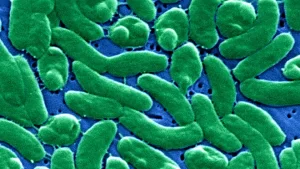Flesh Eating Bacteria Kills 5 in Florida: How to Stay Safe This Summer

🔍 What is “flesh‑eating bacteria”?
The term flesh‑eating bacteria commonly refers to Vibrio vulnificus, an aquatic microbe that thrives in warm, salty, or brackish water. It’s part of a broader category of bacteria that can cause necrotizing fasciitis—a rapidly progressing, tissue-destroying infection that can be fatal if untreated.
Here’s a quick primer:
- Habitat: Coastal waters, particularly when temperatures rise in summer months .
- Infection routes:
- Wound exposure – open cuts or recent injuries that come into contact with contaminated water.
- Ingestion – eating raw or undercooked seafood, notably oysters.
- Disease progression: Can lead to vibriosis—ranging from gastrointestinal distress to bloodstream infection and tissue necrosis—rapidly advancing over hours to a few days.

Current Florida Outbreak: 5 Lives Lost
What’s happened this summer?
- 5 deaths have been reported in Florida so far in summer 2025 due to Vibrio vulnificus
- 11 confirmed cases statewide, spanning Hillsborough, Bay, Broward, St. Johns, Duval, Escambia, Lee, Manatee, Santa Rosa, Walton counties.
- Victims ranged from wound exposure to contaminated water and consuming raw seafood. Bay County most recently reported one fatality.
Why now?
- Warmer coastal waters: Summer months (May–October) are prime time for vulnificus, with rising temperatures increasing bacterial load.
- Post-storm flooding: Heavy rains and hurricanes push contaminated water inland, increasing exposure risk.
- Increased human activity: More people swimming, fishing, and eating shellfish heightens exposure.
Who’s Most at Risk?
The infection affects anyone, but certain groups face a dramatically higher risk:
- People with liver disease, such as cirrhosis or hepatitis
- Immunocompromised individuals (HIV/AIDS, chemotherapy, etc.)
- Those with diabetes, cancer, kidney failure, or low stomach acid
- Elderly – age-related immune decline
Even healthy individuals can suffer severe infection if exposed via open wounds.
Spotting the Signs Early
Two primary infection types:
- Gastrointestinal/foodborne
- Symptoms: vomiting, diarrhea, abdominal pain, fever
- Wound-related/necrotizing fasciitis
- Symptoms: pain, reddened and swollen skin, blisters, ulcers, rapid spread, fever, chills, vomiting, diarrhea.
- Serious complications: septicemia, low blood pressure, tissue death, often fatal—50% of bloodstream cases end in death, sometimes within 48 hours .
- Requires immediate medical intervention to avoid limb loss and fatality .
If you experience severe pain in a wound, swelling, fever, or discharge after water or seafood exposure, go to the ER immediately and inform staff about possible exposure.
Prevention: Staying Protected
1. Avoid high-risk water exposure
- No swimming/bathing in salt or brackish water if you have open cuts, abrasions, or fresh tattoos/piercings.
- Wear water shoes or protective gloves if at risk; guard against cuts from shells or debris.
2. Handle seafood safely
- Skip raw shellfish, particularly oysters—the risk is high.
- Cook thoroughly: boil until shells open plus additional 3–10 minutes; fry oysters at 375 °F for at least 10 minutes.
- Prevent cross-contamination: separate raw seafood from other foods; wash utensils, cutting boards, and hands .
3. Care for wounds immediately
- After water exposure, wash any wound thoroughly, disinfect, and apply bandages .
- Avoid putting bandages back in water.
- Monitor wounds for redness, swelling, fever, heat, discharge—don’t wait to see a healthcare provider .
4. High-risk individuals: extra caution
- Chronic liver disease, diabetes, cancer, kidney issues, immune suppression → highest risk—avoid raw seafood and unprotected water exposure entirely .
Treatment Options: Quick Response Matters
If infected, treatment depends on severity:
- Antibiotics: Doxycycline + third-generation cephalosporins (ceftazidime or ceftriaxone); fluoroquinolones like ciprofloxacin also used.
- Surgical intervention: Removes dead tissue—debridement or amputation if necessary.
- Supportive care: IV fluids, vasopressors for septic shock, intense wound care.
Prompt response is crucial—every hour counts to prevent severe complications or death.
Why These Outbreaks Happen Now
- Climate change: Warmer water temperatures extend the season and expand regions suitable for vulnificus.
- Extreme weather: Hurricanes/floods push contaminated water into inland areas; spikes noted after Hurricanes Ian (2022) and Helene (2024).
- Increased coastal activity: Vulnerable individuals engaging in fishing, swimming, or waterfront activities raise exposure risks.
Staying Safe This Summer: Quick Checklist
| Precaution | Action |
| Wounds | Keep cuts clean and bandaged; avoid exposure in water |
| Seafood | Cook thoroughly; skip raw oysters |
| Symptoms | Seek medical care immediately if pain, swelling, fever, GI symptoms appear |
| High-risk individuals | Extra vigilance: avoid risky exposures entirely |
| Post-storm caution | Avoid swimming in floodwaters or newly inundated zones |
Real Voices, Real Risk
From Bay County, a victim’s story circulated: “A small toe cut… within hours, it ballooned, blistered, and pain exploded. By the time they got him to the ER, tissue damage was deep”.
University of South Florida’s Professor John Sinnott warned:
“People were trying to rescue pets or belongings… They weren’t thinking about what was happening to their legs or feet.”
Dr. Norman Beatty (UF Infectious Disease) stressed:
“A delay… has led to heightened complications, including… amputation… and even people who have… passed away.”
Key Takeaways
- Flesh‑Eating Bacteria = Vibrio vulnificus, a fast-acting bacterial infection found in warm coastal waters.
- Routes: wound contact or eating raw/undercooked shellfish.
- Symptoms escalate rapidly—necrosis, sepsis, amputations, death possible.
- Prevention: wound care, cooking seafood, avoiding risky exposures, especially for high‑risk people.
- Treatment = immediate antibiotics + potential surgery; survival hinges on timing.
Final Thoughts
With five tragic fatalities this summer and rising sea temperatures, the threat of flesh‑eating bacteria is real. By staying aware and applying simple precautions—keeping wounds clean, cooking shellfish properly, and seeking swift medical care—we can protect ourselves and our loved ones.




